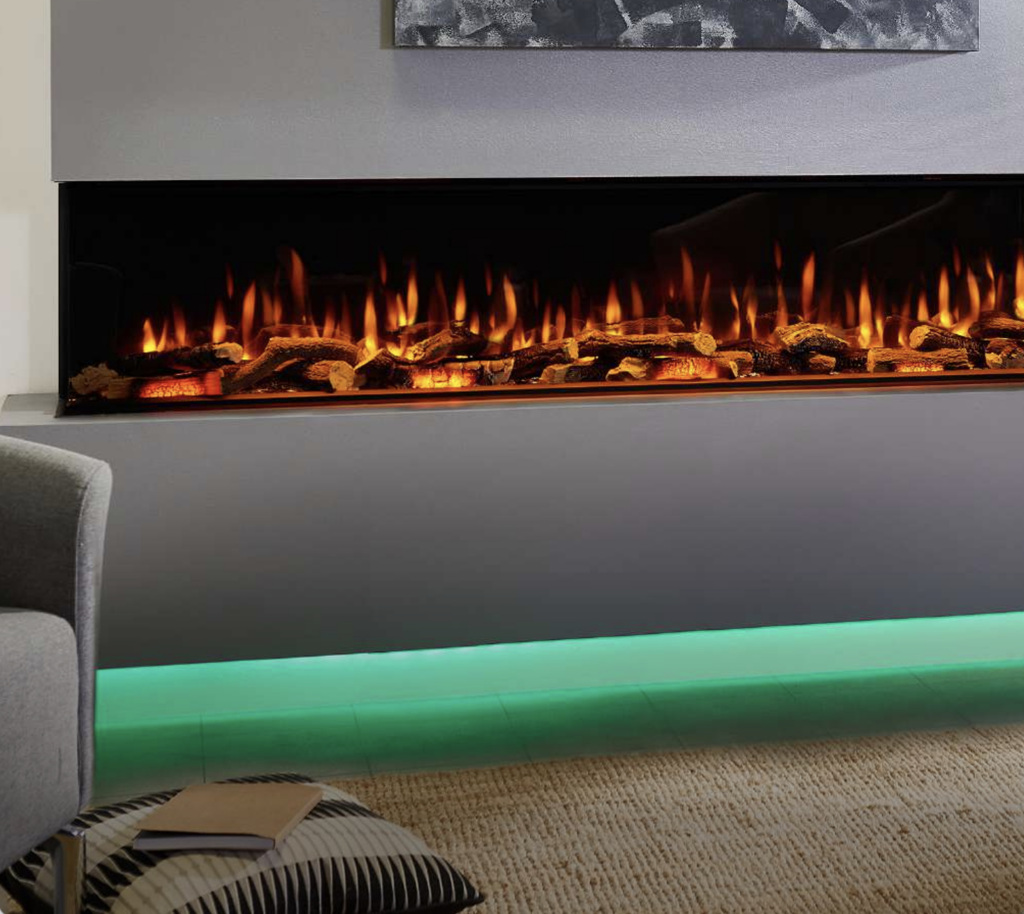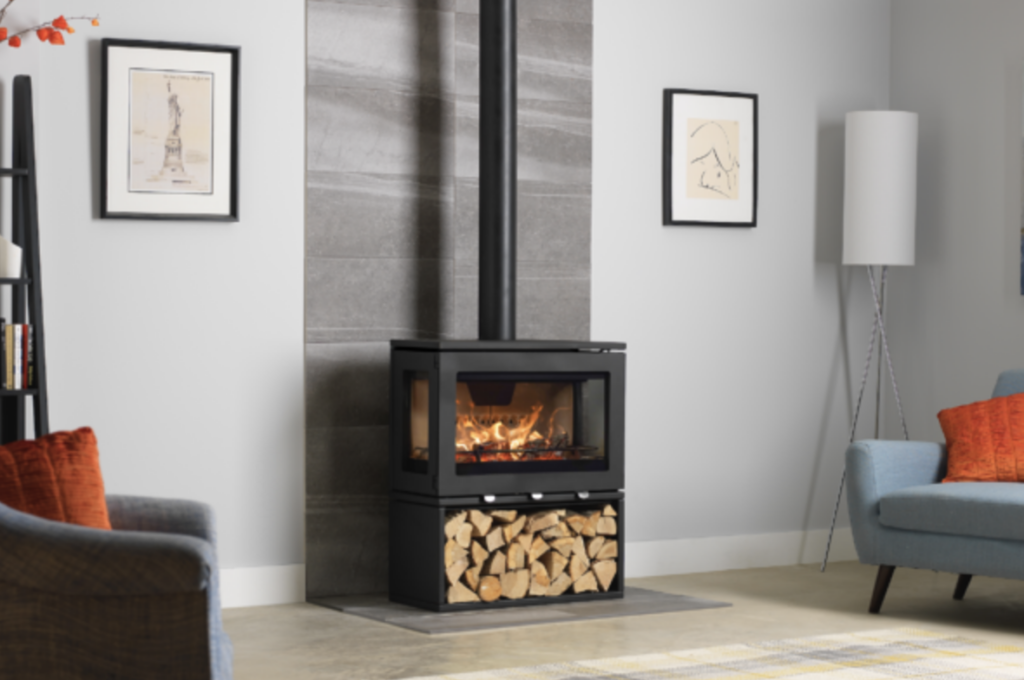When designing our fires, whether wood-burning stoves, electric, or gas, one essential aspect we always prioritise is their ability to create a relaxing ambience in a room. A fire is more than a heating appliance; it serves as a focal point of interior design, influencing the atmosphere and mood of a room. Thoughtfully designed rooms (and fires) not only look appealing but also contribute positively to mental well-being. To help you harness this, we’ve listed several interior design tips aimed at enhancing your mental health and promoting relaxation in your own home.
In today’s fast-paced, stressful world, creating a peaceful and nurturing home environment has become essential for mental well-being. Our surroundings impact mood, productivity, and overall mental health. Thoughtful interior design can reduce stress, anxiety, and even symptoms of depression.
Here are a few practical and effective interior design tips to enhance mental health:
1. Utilise Natural Light
Natural sunlight boosts mood and regulates circadian rhythms, significantly impacting mental health. Incorporating natural light into interior spaces can combat feelings of depression and anxiety.
Tips:
Use sheer curtains to allow sunlight.
Position desks and seating near windows.
Install mirrors opposite windows to amplify natural light.

2. Embrace Biophilic Design
Biophilic design connects interior spaces with nature, promoting mental wellness through reduced stress levels and increased feelings of tranquillity.
Tips:
Incorporate indoor plants like peace lilies, pothos, or snake plants.
Use natural materials such as wood, stone, and bamboo.
Include nature-inspired patterns and artwork.
3. Choose Calming Colours
Colour affects mood and emotion. Calming colours can reduce anxiety and promote feelings of relaxation and peace.
Tips:
Opt for soft blues, greens, neutrals, and pastel tones.
Avoid overly vibrant or stimulating colours in restful spaces like bedrooms.
Use colour accents strategically to energise areas like home offices or gyms.
Here is more insight into colours and how they add a specific vibe to a room:
Off-White – A warm, welcoming alternative to stark white.
Beige – Adds warmth and cosiness while keeping a clean look.
Taupe – A mix of grey and brown for a sophisticated, earthy tone.
Blush Pink – Adds a soft, romantic, and airy feel.
Baby Blue – Creates a fresh, tranquil, and light ambience.
Mint Green – Refreshing and soothing, ideal for relaxation.
Lavender – Gentle and elegant, great for bedrooms and living rooms.
Sage Green – A muted, natural green that brings in an organic, peaceful vibe.
Warm Grey – A subtle and sophisticated choice that pairs well with various styles.
Dusty Peach – A warm and inviting shade with a hint of vibrancy.
Pale Aqua – A light blue-green that feels refreshing and airy.
Soft Periwinkle – A subtle blue-purple for a dreamy, relaxing space.
Muted Sky Blue – A delicate shade that enhances openness and calmness.
Below is our iRange i2200e Deep electric fire, shown with optional LED lighting.

4. Declutter and Simplify Spaces
A cluttered environment can cause stress, reduce productivity, and negatively impact mental clarity. Maintaining organised spaces helps create a sense of calm and control.
Tips:
Regularly declutter and organise spaces.
Invest in storage solutions such as built-ins, shelves, and cabinets.
Adopt minimalistic design principles, focusing on fewer, meaningful items.

5. Create Personal and Cosy Spaces
Personalisation in design creates emotional comfort and a sense of identity, essential for mental well-being.
Tips:
Personalisation includes using personal things like photos
Create cosy reading areas with comfortable furniture and soft lighting.
Use textiles like rugs, throws, and cushions to enhance comfort.
6. Incorporate Sensory-Friendly Elements
Design elements that cater to various senses can significantly improve mental health by creating a calming sensory experience.
Tips:
Introduce soft, tactile materials like velvet or plush fabrics.
Add gentle, ambient lighting for evenings.
Utilise essential oils or scented candles with calming fragrances like lavender and chamomile.
7. Optimise Spaces for Social Interaction Colours
Social connection is essential for mental health. Spaces designed for comfortable social interaction can help reduce feelings of isolation.
Tips:
Arrange furniture to facilitate conversation, creating comfortable seating areas.
Provide accessible spaces for social gatherings, such as dining areas and cozy lounges.
Integrate technology mindfully, creating spaces conducive to both digital and physical interactions.
8. Design Quiet Retreats
If you have space, incorporating areas for meditation, relaxation, or solitude is helpful in maintaining mental wellness, providing necessary breaks from everyday stress.
Tips:
Dedicate a quiet corner or room for meditation or mindfulness activities.
Furnish these areas minimally, using comfortable seating and calming decor.
Reduce technological distractions in these designated spaces.
9. Ensure Good Air Quality
Poor indoor air quality negatively impacts cognitive function, sleep quality, and overall mood.
Tips:
Include air-purifying plants to enhance air quality naturally.
Regularly maintain HVAC systems.
Use air purifiers and maintain humidity levels with humidifiers or dehumidifiers as needed.
Swap an open fire for an Ecodesign wood-burning stove
Only burn seasoned wood!

10. Incorporate Artwork and Inspirational Elements
Visual things like your preferred artwork can significantly uplift mood and motivation.
Tips:
Display artwork that resonates personally and promotes positive emotions.
Include motivational quotes or affirmations in strategic areas like workspaces and bedrooms.
Rotate artwork periodically to maintain visual interest and emotional engagement.
What about Wood-Burning Stoves?
Wood-burning stoves possess a unique magic that other fires can’t match, effortlessly soothing and captivating with one irresistible feature: the real flame. There is an enchanting quality in dancing flames that gently calms the mind. Here are just a few reasons why the warm glow and gentle flicker of a wood-burning stove create such a relaxing ambience:
Visual Appeal: The gentle flicker and warm glow of real flames naturally soothe the mind, providing a calming visual focus.
Ambient Sound: The subtle crackling and popping sounds from burning wood create comforting, ambient white noise that can reduce stress and anxiety.
Warmth and Comfort: The radiant heat from a wood-burning stove provides deep, gentle warmth, helping to relax muscles, ease tension, and promote a cosy atmosphere.
Connection to Nature: Burning natural wood evokes a sense of being closer to nature, which is calming and grounding, helping to reduce feelings of stress.
Mindfulness and Ritual: The simple, mindful activities involved, like stacking wood, lighting the fire, or tending to it, can be calming rituals that enhance relaxation and mental clarity.
Conclusion
Interior design has a profound influence on mental health, offering a powerful tool to foster emotional well-being and reduce stress. If you own a stove, you have a great focal point for elevating a relaxed vibe in a room.
By thoughtfully incorporating natural elements, calming colours, personalised and organised spaces, sensory-friendly features, and areas dedicated to social interaction and quiet reflection, a home can become an essential sanctuary supporting mental and emotional health.








